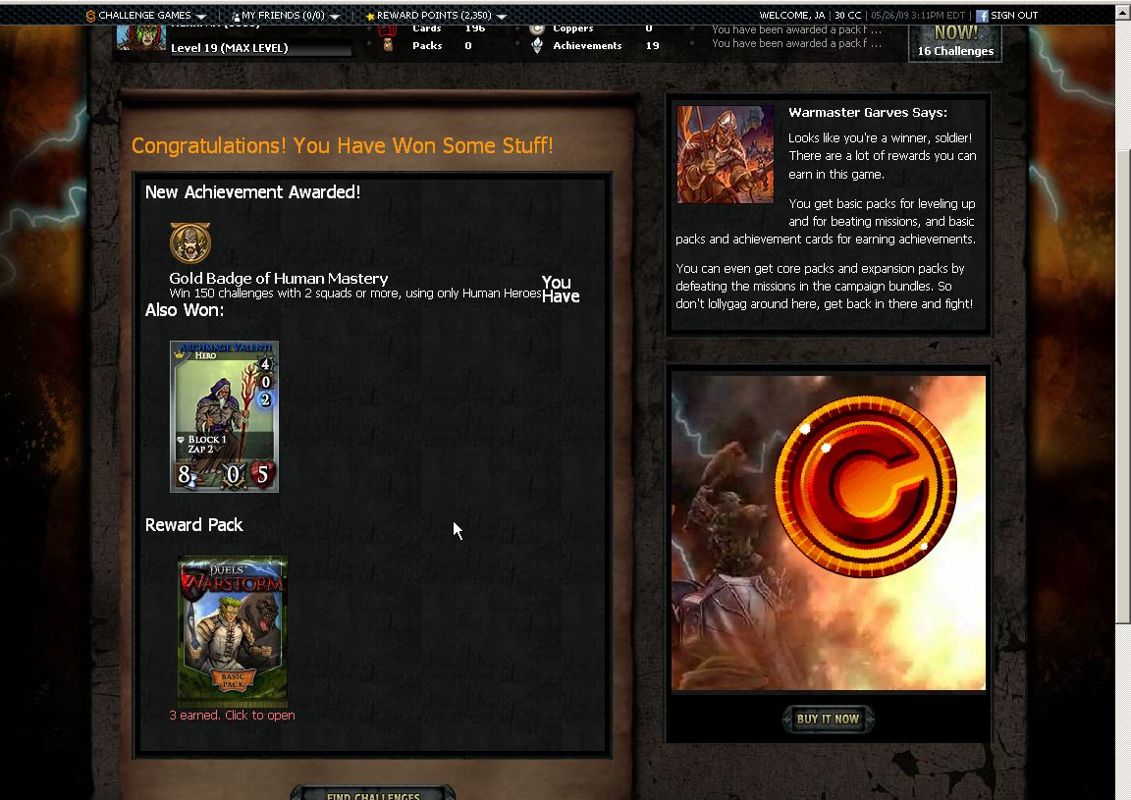Retro Replay Review
Gameplay
Duels: Warstorm delivers a streamlined collectible card game experience that emphasizes strategic squad-building over manual battle controls. You begin with a basic deck of cards and craft up to 16 squads—each led by a hero and filled with six additional units, artifacts, or spells. This structure challenges players to think several moves ahead, balancing offensive power, defensive resilience, and tactical versatility. As new cards roll in through campaign victories, achievements, or optional purchases, your squad compositions grow richer and more nuanced.
(HEY YOU!! We hope you enjoy! We try not to run ads. So basically, this is a very expensive hobby running this site. Please consider joining us for updates, forums, and more. Network w/ us to make some cash or friends while retro gaming, and you can win some free retro games for posting. Okay, carry on 👍)
The automatic resolution of battles places all focus on pre-battle planning rather than real-time execution. While this might disappoint fans of hands-on combat, it allows for brisk pacing: matches wrap up in moments, keeping the action flowing swiftly. Victory often hinges less on luck and more on understanding card synergies—pairing creatures that complement one another and deploying spells at optimal moments. This system rewards foresight and creative deck-building, making every new card acquisition feel meaningful.
A notable feature is the avatar synchronization with the original Duels game, meaning your customized avatar and its equipment carry over to Warstorm. Although these cosmetic elements have no bearing on match outcomes, they deepen the sense of continuity for returning players. The ability to showcase a personalized character profile adds flair and identity to your card battles, bridging two distinct titles without unbalancing the strategic core.
Graphics
The visual presentation of Duels: Warstorm leans into high-fantasy card art, offering detailed illustrations for each unit, spell, and artifact. Characters range from rugged warriors to mythical beasts, rendered with attention to color and texture. While some art pieces feel reminiscent of other collectible card games, the overall aesthetic is cohesive, ensuring each card is immediately recognizable on the battlefield grid.
UI elements are crisp and functional, with clear icons denoting health, attack power, and special abilities. The squad-selection screen is intuitive: drag-and-drop mechanics make deck adjustments straightforward, while tooltips provide concise card descriptions. During auto-resolved battles, animations are kept brief—units march forward, spells unleash their effects, and health bars tick downward. These modest animations strike a balance between visual polish and brisk pacing, maintaining player engagement without overstaying their welcome.
One of the standout graphical touches is the avatar display, borrowed from Duels. Your hero is showcased in full 3D, decked out with armor, weapons, and accessories earned in the parent game. Although purely aesthetic in Warstorm, seeing that avatar appear beside your squads adds a personalized flourish. It’s a subtle reminder that this is more than just a card game—it’s an extension of your broader fantasy persona.
Story
While Duels: Warstorm’s narrative backdrop isn’t its primary focus, the single-player campaigns offer bite-sized story arcs that frame each mission. You’ll embark on quests against rival factions, defend besieged strongholds, or recover lost artifacts. Though each chapter’s plot is relatively straightforward, the well-written flavor text on cards and mission briefings helps build a sense of epic conflict.
The lore is delivered piecemeal through campaign objectives and card descriptions rather than through lengthy cutscenes or dialogue trees. This approach keeps the story moving at a brisk pace, appealing to players who prefer jumping straight into deck construction and battles. For lore enthusiasts, the game hints at deeper world-building—ancient rivalries between wizard orders, legendary artifact hunts, and the rise of new champions—but leaves much open to interpretation.
Compared to narrative-heavy TCGs, Warstorm’s story is serviceable but not groundbreaking. It serves its purpose by providing context for campaign battles and enriching card flavor, but it won’t satisfy those seeking a richly woven epic. Instead, it strikes a middle ground, offering enough lore to spark the imagination without detracting from the core card-based gameplay.
Overall Experience
Duels: Warstorm excels as a free-to-play collectible card game that offers genuine depth without overwhelming newcomers. The basic version grants access to essential cards and campaigns, making it easy to sample the game’s core mechanics. For dedicated players, purchasing additional campaigns and card packs expands deck-building options and prolongs the experience. Despite optional microtransactions, progression feels fair—grinding missions and achieving objectives yield a steady trickle of new cards.
The unlimited PVP duels provide endless replayability, pitting your squad designs against those of other strategists. Climbing the leaderboards or simply experimenting with unconventional card combinations keeps the metagame fresh. The automatic battle system ensures quick match turnover, making it ideal for both short play sessions and marathon strategy nights. The avatar sync with Duels acts as a compelling incentive for veterans, fostering continuity and personal investment.
While the lack of direct control during battles may not suit every player, Duels: Warstorm’s emphasis on pre-battle strategy and card synergy stands out in a crowded genre. The polished UI, strong card art, and the hook of a connected avatar identity create a cohesive package. Whether you’re a seasoned TCG veteran or a newcomer curious about squad-based card combat, Warstorm offers an engaging, accessible, and strategically rewarding journey.
 Retro Replay Retro Replay gaming reviews, news, emulation, geek stuff and more!
Retro Replay Retro Replay gaming reviews, news, emulation, geek stuff and more!









Reviews
There are no reviews yet.